brakes CHEVROLET S10 1997 2.G Owners Manual
[x] Cancel search | Manufacturer: CHEVROLET, Model Year: 1997, Model line: S10, Model: CHEVROLET S10 1997 2.GPages: 402, PDF Size: 21.04 MB
Page 6 of 402
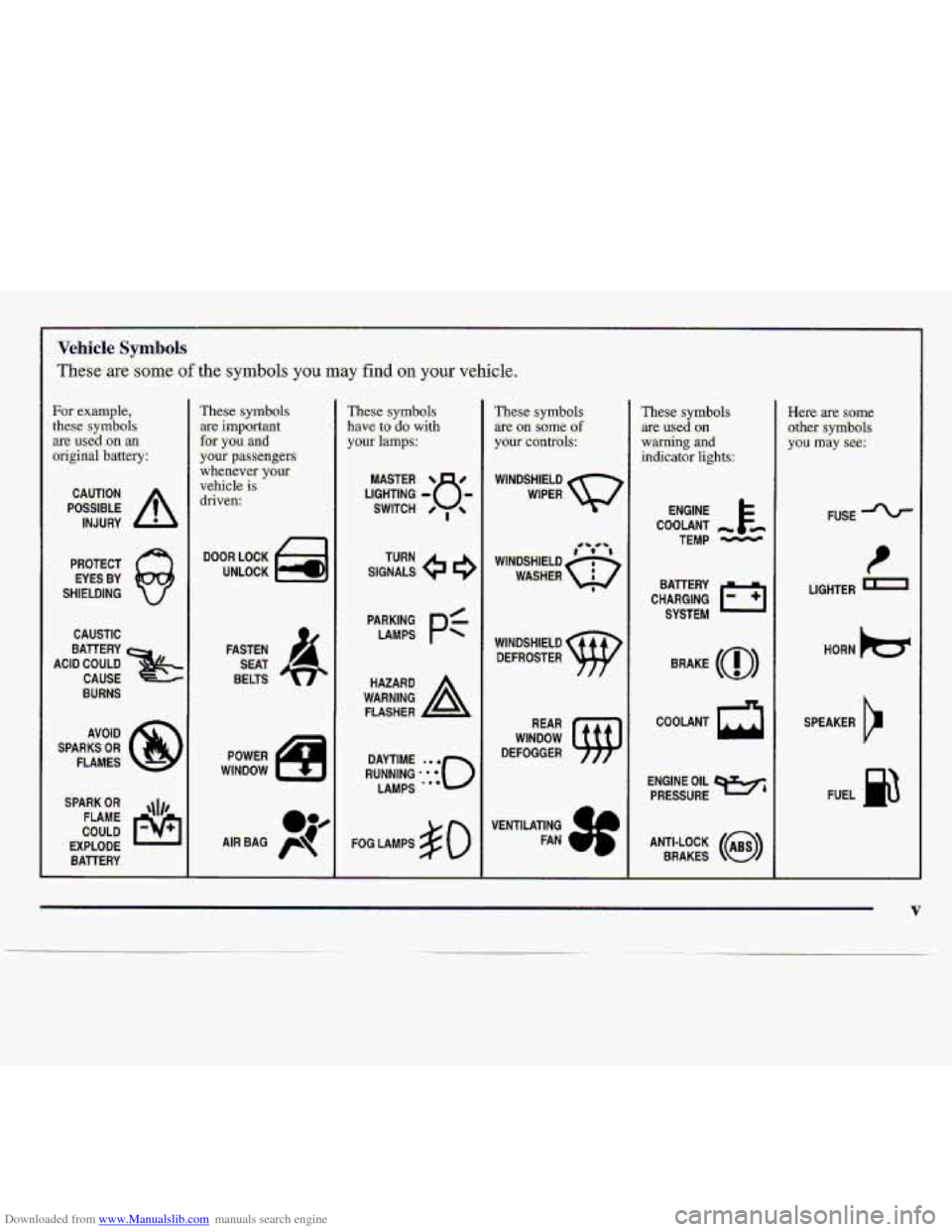
Downloaded from www.Manualslib.com manuals search engine L
Vehkle .Symbols.
These are sa-me of the s,ymbols you may find on your vehicle.
For-example,
these symbols
are used :on an
original battery:
PROTECT EYES
BY
SHIELDING
CAUSTIC
BURNS
SPARK OR ,111,
COULD FLAME
EXPLODE
BATTERY
These- symbols
:are important
for you and
yo,ur passengers
whenever your
vehicle is
driven:
DOOR LOCK
UNLOCK
FASTEN
SEAT
'BELTS
POWER
WINDOW
These symbols
have to do. with
your iamps.:
LlGmmI ING
.SIGNALS.
6 e3
TURN
WARNING A
HAZARD
FLASHER
FOG LAMPS
$0
These symbols
are on some Qf
your daritroh:
WINDSHIELD WIPER
WINDSHIELD
WINDSHIELD 'DEFROSTER
WiNDOW
DEFOGGER
These symbols
are used oil
warning and
indicator lights:
-BATTERY
CHARGING
SYSTEM
BRAKE (@)
ENGINE OIL w,
PRESSURE
Here are so.me
dther symbols
you may see:
FUSE -%F
I
LIGHTER
HORN
ttT
,SPEAKER
b
FUEL. p3
ANTI-LOCK (@)
BRAKES
V
.."
Page 66 of 402
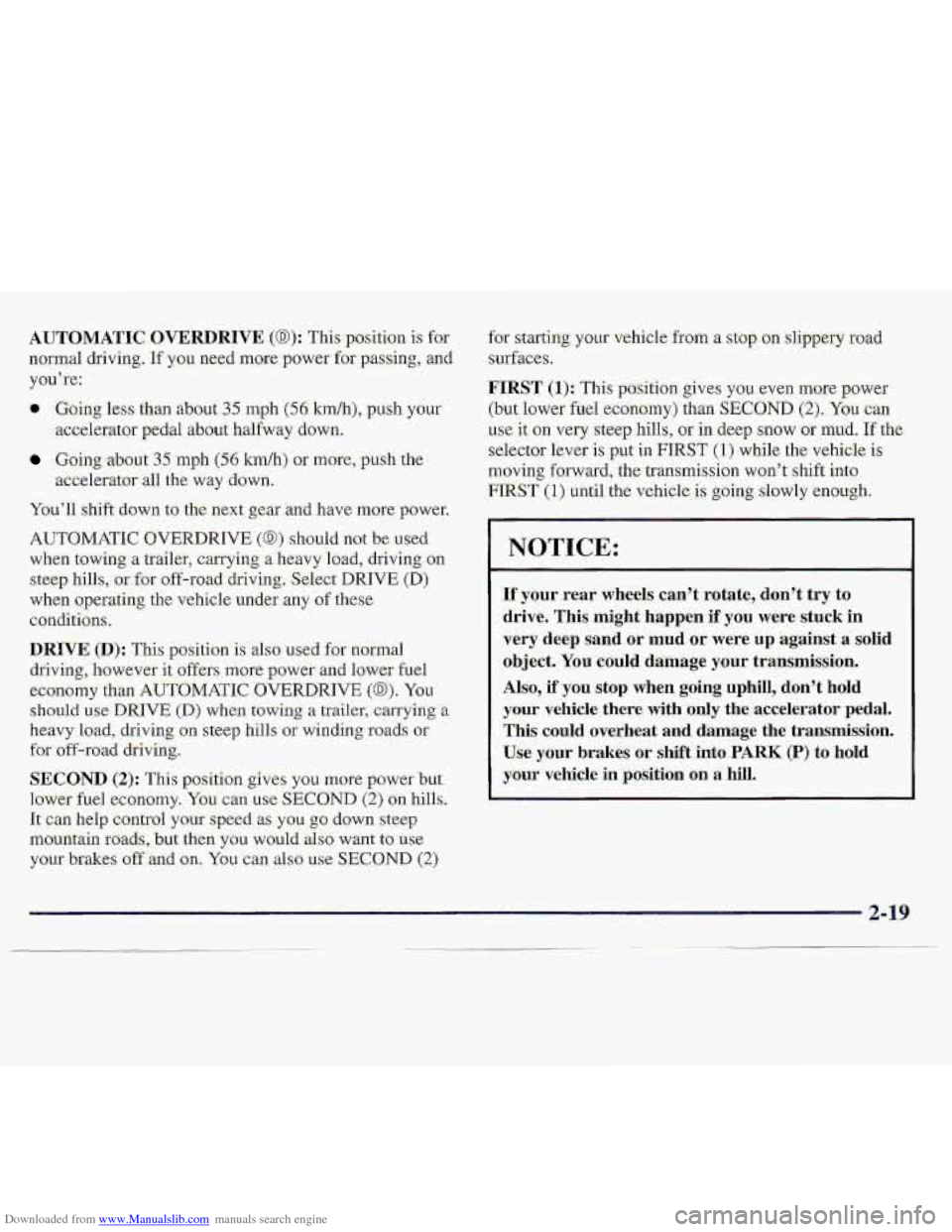
Downloaded from www.Manualslib.com manuals search engine AUT-OMATIC OVERDRIVE (@): This yosition is for
normal driving. If y.ou need more :power for passing, and
yodre:
(r, GQing less than about 35 mpli (56: krnlh), push your
axelerator p:edal about halfway down.
Going< about 35 inph (56 knci/h> or more, push the
accelerator all the way down.
You'-ll shift down to the next gedr and have more power.
AUTOMATIC OVERDRIVE (0) should not b.e used
when towing
a trailer, carrying a heavy load, driving on
steep.
hills, 6r for off-road-driving.. Selecr DRIVE (D)
when operating the vehicle under any of these
conditions.
DRIVE @): This position is also use.d for normal
driving,'however it offers more power -and lower fuel
economy than AUTQMATIC -aVERDRIVE (a). You
should use DRIVE (D) when rowing a trailer; carrying a
heavy load, driving. on steep hills or winding roads or
for .off-road driving.
SEC-OND (2): This position gives. you more power but.
lower fuel economy.' You can use SECOND (2) aji hills.
It can help control your speed as-you go .down steep
mountain
roads., but then you would..also want to use
your brakes off-and on. YOU can ds~ use SECOND (2)
2-19
Page 75 of 402
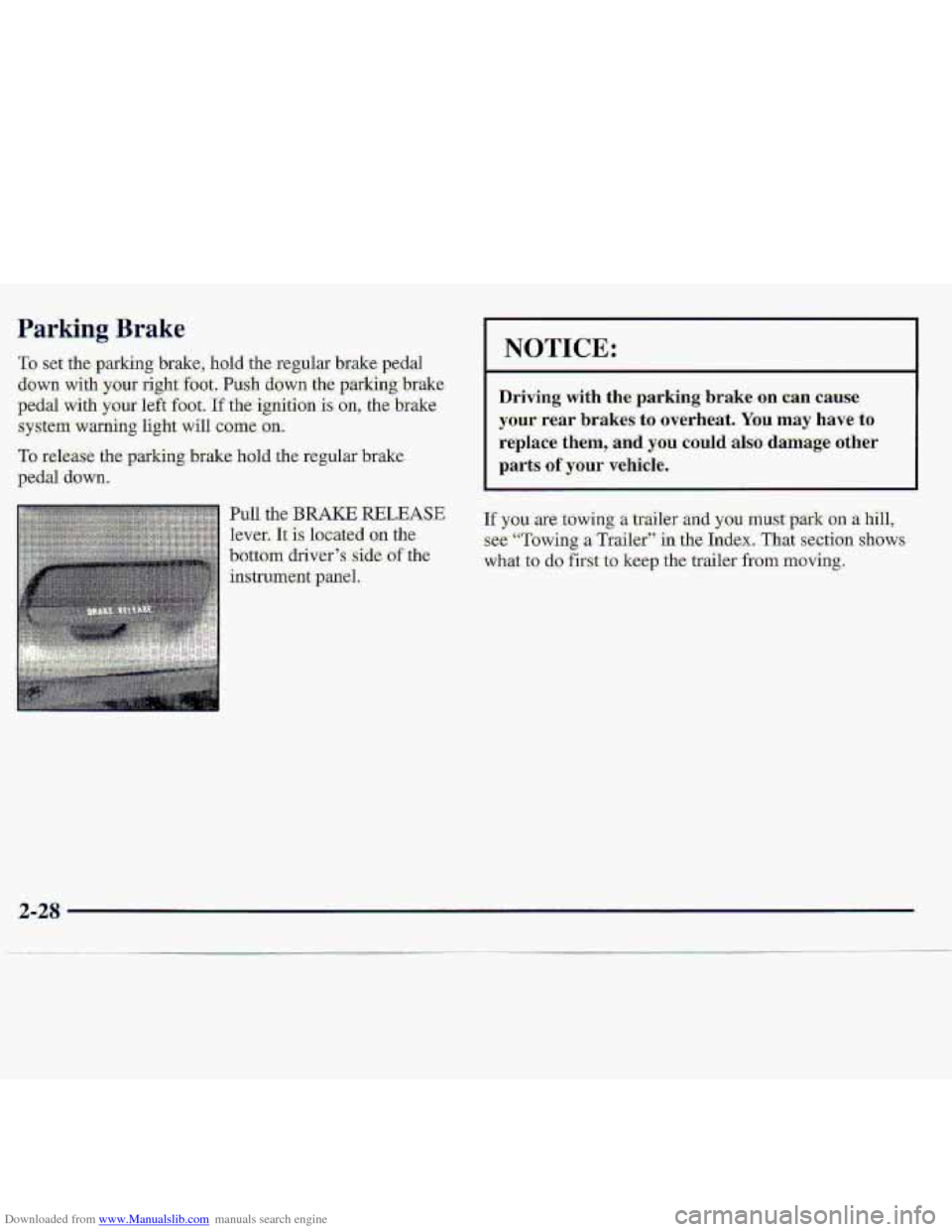
Downloaded from www.Manualslib.com manuals search engine Parking Brake
I NOTICE: I
Driving with .the:p.arking brake on c=an.cause
your- rear brakes to overheat. Y0.u may have to
replace them, and you. could .also-damage other
parts of your vehicle.
If you. are towing a trailer and.you must. park on a hill,
see--"Towing a Trailer" in. the Iadex. That section shows
what to
do first- to. ke.ep the trailer from moving.
Page 87 of 402
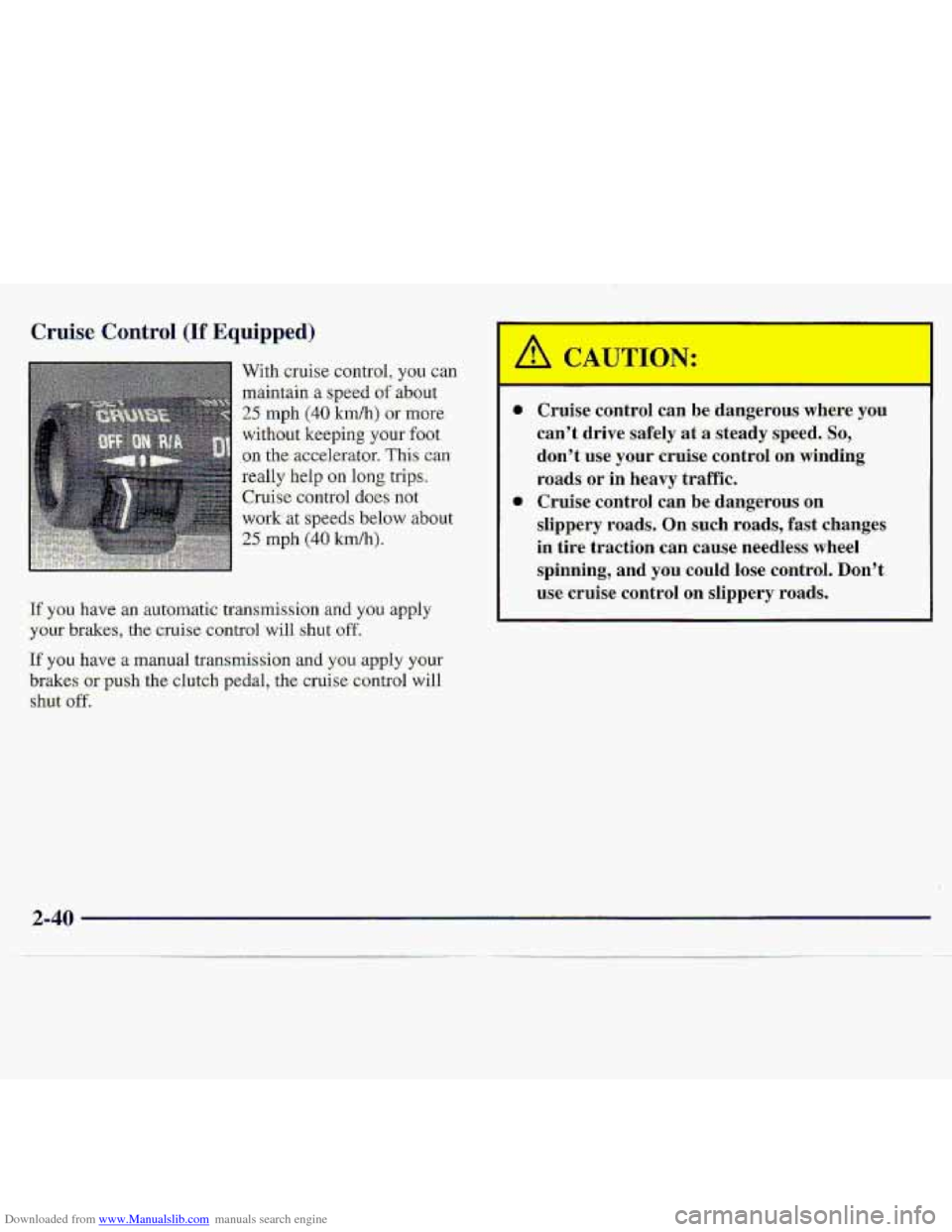
Downloaded from www.Manualslib.com manuals search engine Cruise Control (If Equipped)
-With cruise control, you can
.maintain a speed of about
25 mph (40 km/h) or more
without keeping your foot
on the-accelerator. This can
really help on long trips.
Cruise control does not
work-at speeds belo-w about
25 mph (4.0 kdh).
If you have an automatic transmission and y.0~ apply
your brakes, the cruise control will shut off.
:If you have a manual transmission and you apply your
brakes
or push the clutch pedal, the cruise control will
shut off:
@ Cruise control can be dangerous where you
can’t drive safely aka steady
speed. So,
don’t use your cruise control on winding
roads or in heavy traffic.
slippery
roads. On such roads, fast changes
in
tire traction can cause needless. wheel
spinning, and you could lose control. Don’t
use cruise control on slippery
roads.
a Cruise control can be dangerous on
2-40
Page 105 of 402
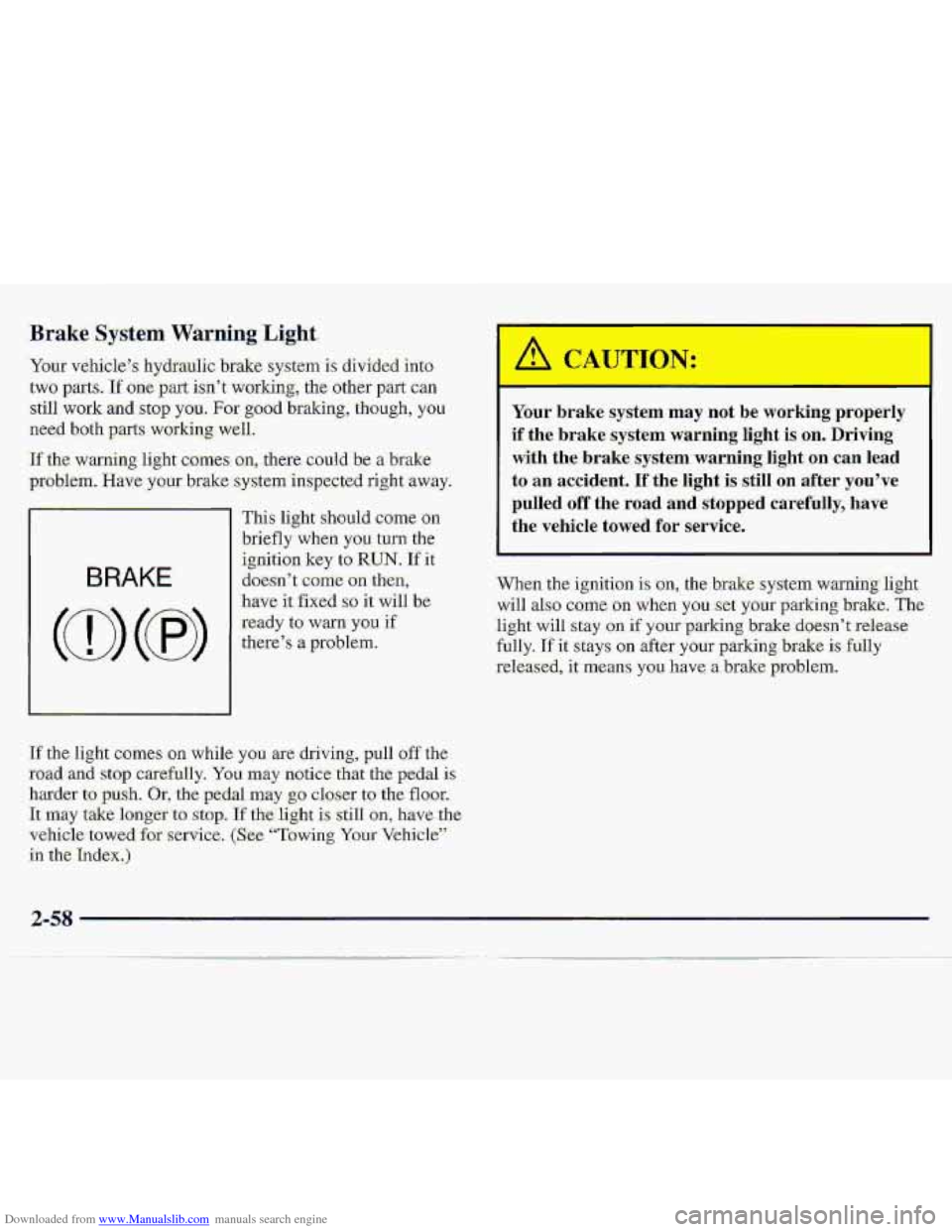
Downloaded from www.Manualslib.com manuals search engine .Brake System WarningLlght
‘Your v&iiele”s hydraulic brake system is divided into-
.two pam. If one part i.sn’t working, thc other part. can
-still work and stop you. For go.od haking, though, you
need both parts working well.
‘If the warning. light comes- an, thae could be a brake
problem. Have ymr brake system inspected right -away.
BRAKE
I
This li.ght shouId came on
briefly when you turn the
ignition key
to RUN. If it
do-e-sn’
t come on then,
have it fixed so it will be
ready to warn you if
t11ei3e7.s 8 problem..
If the light camcs .gn while you are- driving, pull off the
road aid stop carefully. You may notice ,that the pedal is
.harder-t=o push. Or, the pedal may $0 closer to the floor.
‘kmay ‘take ionger to. stop. If the-light is sail1 on, have the-
vehicle
tawed for service, (S:ee- “Towing Your Vehicle”’.
in the
Index.)
J:
Your brake sysrem may not be working properly
if
the brake system warning light is on. Driving
with the brake system warning light on can lead
to an accident. If the light is still on after you’ve
pulled off the road and stopped carefully, have
the vehicle
towed for service.
.When the ignition is on, the brakesystem warning light
will also c0rn.e oa when yo.u.:set y.@ur parking brake. The
light will stay .on if your parking brake doesn’t release
fully.
If it stays on after your parking brake is fully
-released,
it means you have a brake problem.
2-58
Page 143 of 402
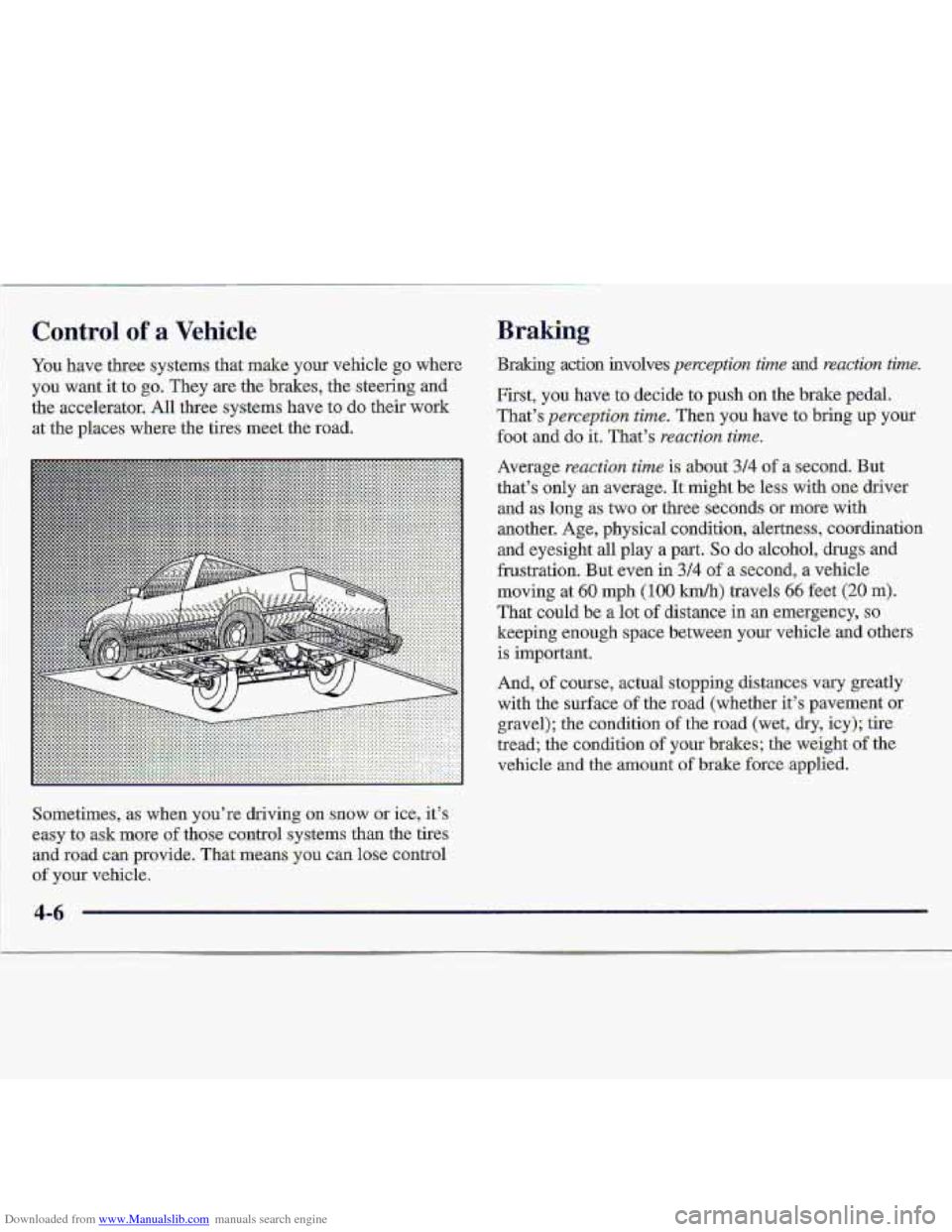
Downloaded from www.Manualslib.com manuals search engine You have three systems that make your vehicle go where
you want it to
go. They are the brakes, the steering and
the accelerator. All three systems have to do their work
at the places where the tires meet the-road. Braking action involves
perception
time and reaction time
First, you have to decide to push ob the brake pedal.
That’s
perception time. Then you.have to bring up your
foot and
do it. That’s reaction time.
Average reaction time is -about 3/4 of a second. But
that’s only an average. It might
.be less with me driver
and
as long as two or three seconds or more with
another. Age., physical condition, alertness, co.ordinati.on
and eyesight
all play a part. So do aIcohol, drugs and
frustration.
But even in 314 of a second, a vehicle
moving at
60 mph (100 km/h) travels 66 feet (20 m).
That could be a lot of distance in an emergency, so
keeping -enough space between your vehicle and others
is important,
And,
of course, actual stopping distances vary greatly
with the surface
of the road (whether it’s pavement or
gravel); the condition
of the road (wet, dry, icy); tire
tread; the condition of your brakes; the weight of the
vehicle and the amount
.of brake force applied.
Sometimes,
as when you’re driving on snow or ice, it’s
easy
to ask more of those control systems than the tires
and road can provide. That means you can lase c.ontrol
of
your vehicle.
4-6 .-
Page 144 of 402
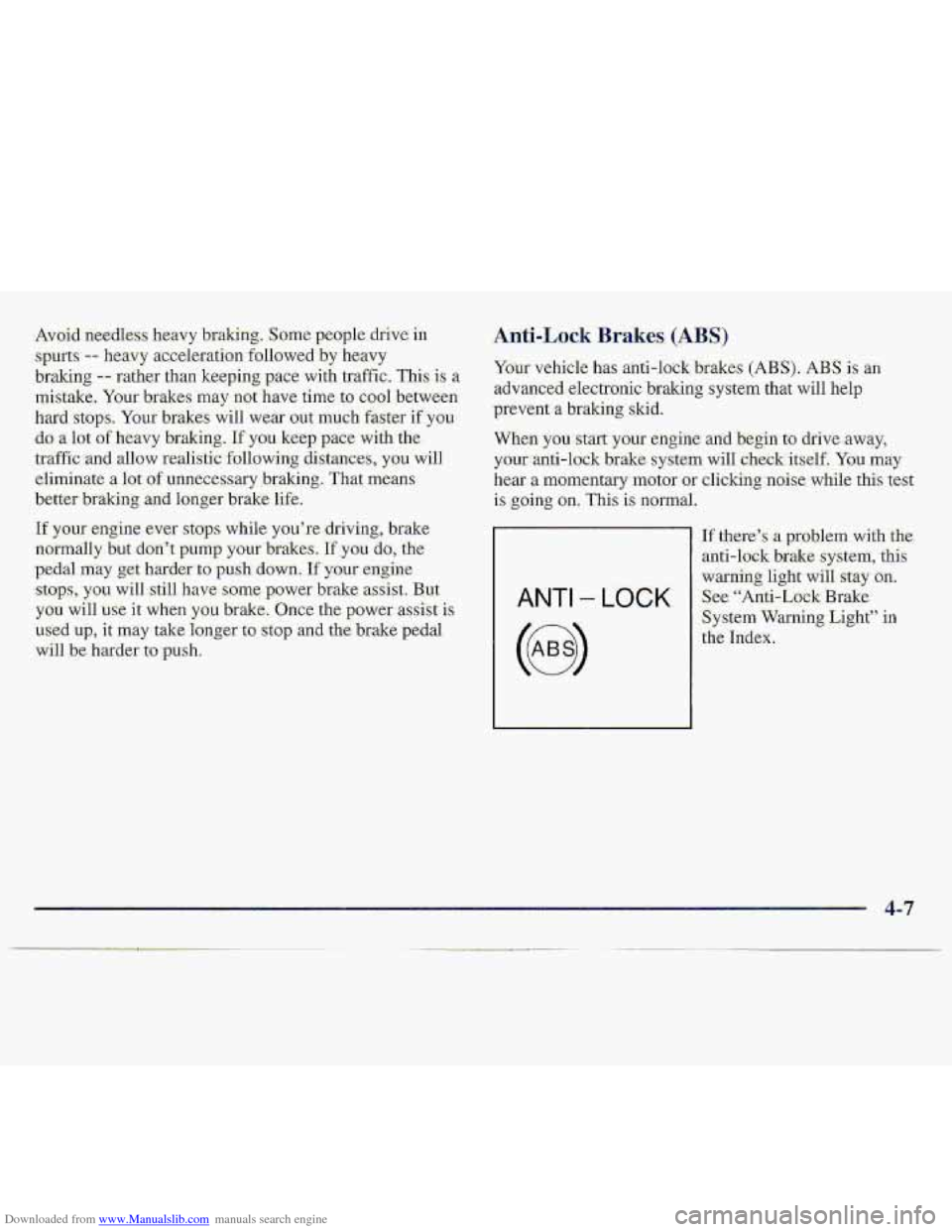
Downloaded from www.Manualslib.com manuals search engine Anti-Lock Brakes (ABS)
Your vehicle has anti-lock bmk& (ABS). ABS is an
advanced .electronic braking systeni that will help
prevent a braking skid.
When you start your engine and begin to drive away,
your-anti-lok
brake system will check. itself. Yau may
hear
a rnsrnentary motor or clicking-noise, w-file this ‘test
is going on. This is normal.
If your-engine ever stqs while you’se driving, brake
normally
but do;n’:t pul~ip your brakes. Ifyou do, th-e
,p%ed-al may get hard-er-to puGh .down. If -your.engi-ne
‘stops, you will-s~tal have some power assist. B:ut
you will a-se it when you brake; Once the power.asskt is
used up, it may take long-er to stop afid thelljrake pedal
will
.be .harder to zrush.
ANTI - LOCK
If there’s a problem with the.
anti-lock brake system, -this
war‘i&g.Iight will stay an.
See. “Anti-Lo& Brake
System
Warning Light” in
th.e Index.
4-7
Page 145 of 402
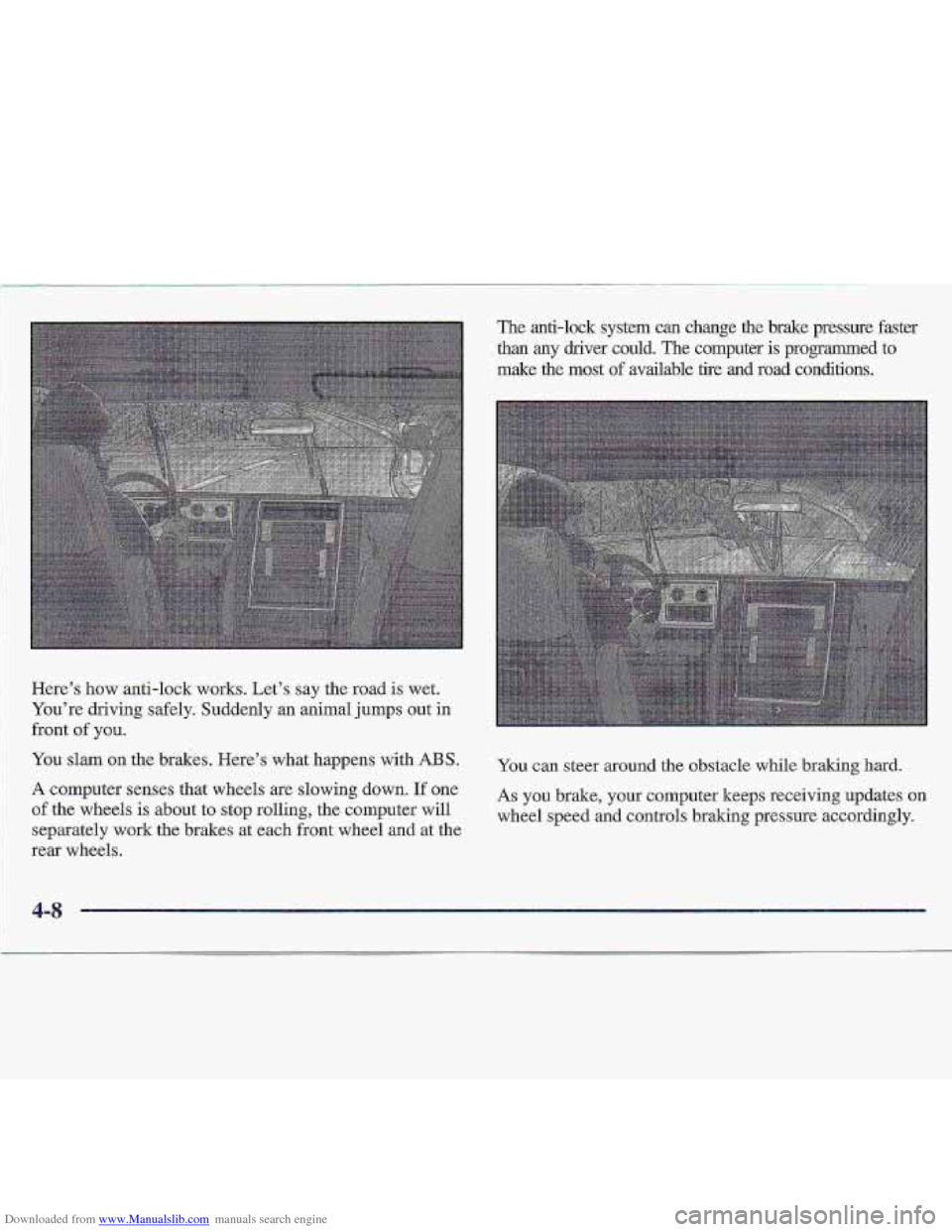
Downloaded from www.Manualslib.com manuals search engine Here’s how anti-lock works. Let’s. say the road is wet.
You’re driving safely; Suddenly-an animal jumps out
in
front of you.
1 You slam on the brakes, Here’s what happens with ABS.
A computer senses that wheels are slowing down. If one
of the wheels is about to stop rolling, the computer will
separately work the brakes at each front wheel and at the
~ rear wheels.
The anti-lock system em change the brake p~essure faster
than any driver could. ?%e computer is programmed to
make the most of available tire and road tronditions.
You cansteer around the obstacle while braking hard.
As you brake, your computer keeps receiving updates- on
wheel speed and controls braking pressure accordingly.
Page 146 of 402
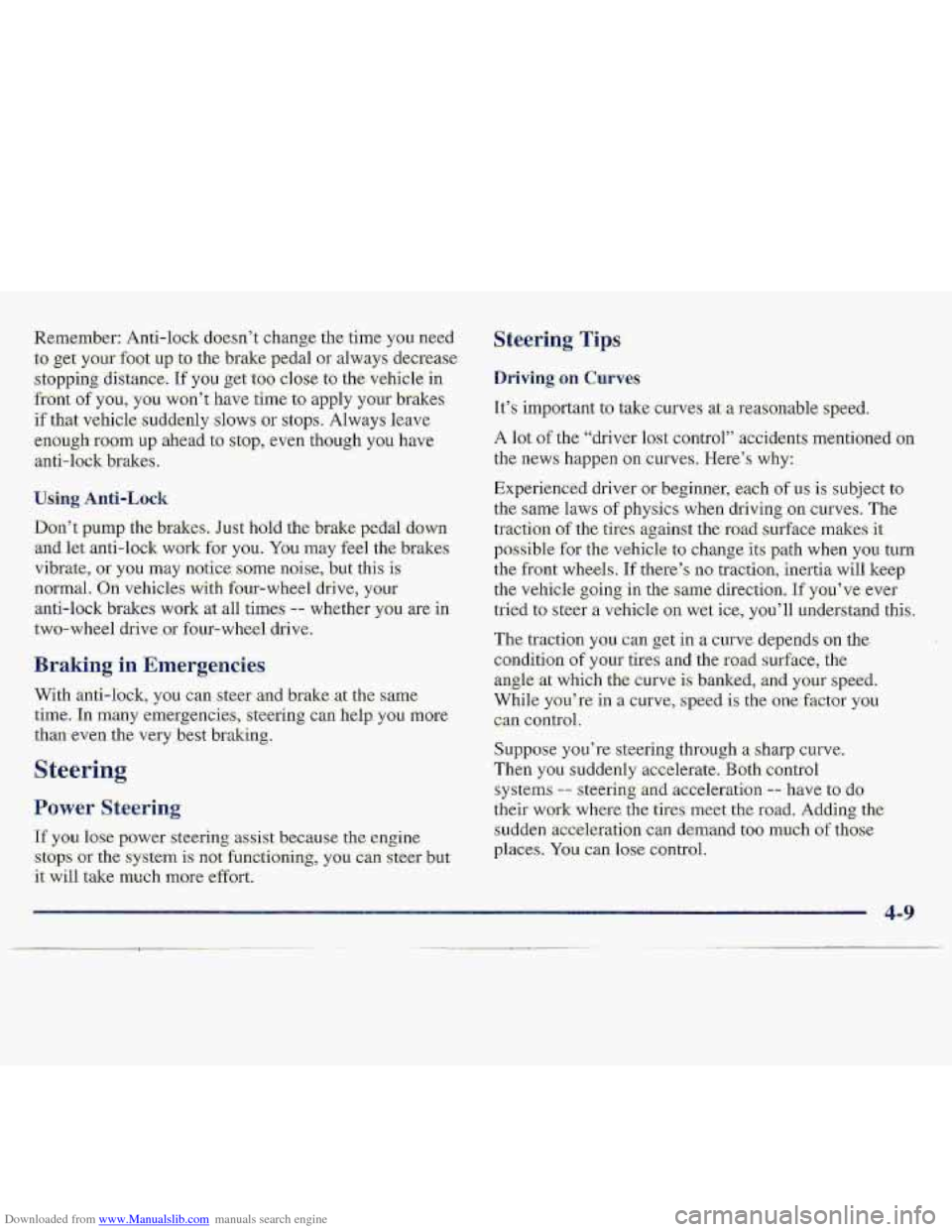
Downloaded from www.Manualslib.com manuals search engine Remember: Anti-lock dsesn’t change tbc- -time y.ou :need
:to get yo.ur fo~t up to .the brake ped,ai or always decrease
stopping
diskan&. If.you get-to6 cl~,se to thcvehicle in
front of YOU; you won’t have time to apply your brzikes
If.th:at vehicle suddelily .slows or siop-s. Always i-eave
e.nough mom up ahead to si.op, even though you have
anti-lockrbpkes.
U.s,ing.Anti.-LthA
Don’t pump the’bisakes. Just hdd the brake pedzl down
and let anti-lock wark..fox you. You ‘may feel the brake.$
vibrate., or you-may notice som-e noise, but this is-
::normal. Ofi vehicles Mth-four-wheel drive, your
;anti-lockbrakes work at all times- -- whether ,you are in
two-wheel driveor fuur-wheel:&.ive.
Braking in Emergencies,
With m-ti-lock, you can steer and brake at thc same
.time-. In many emergencies., st.eering can kip, you more
than even the very $est braking.
Power Steering
If you lose p~wer steeringatssist because the e.ngine
stop;s or the system is not fiw.dt?orriag, you can ste.er .but
it will take much more effort.
Steering Tips
It’s important to take c.urv.es at a reasonable sp-eed.
A lot of the “drivet lo‘st ci3ntml”‘accidents meritionedl ~li
the slews happen on curves. Here’-s why
Page 150 of 402
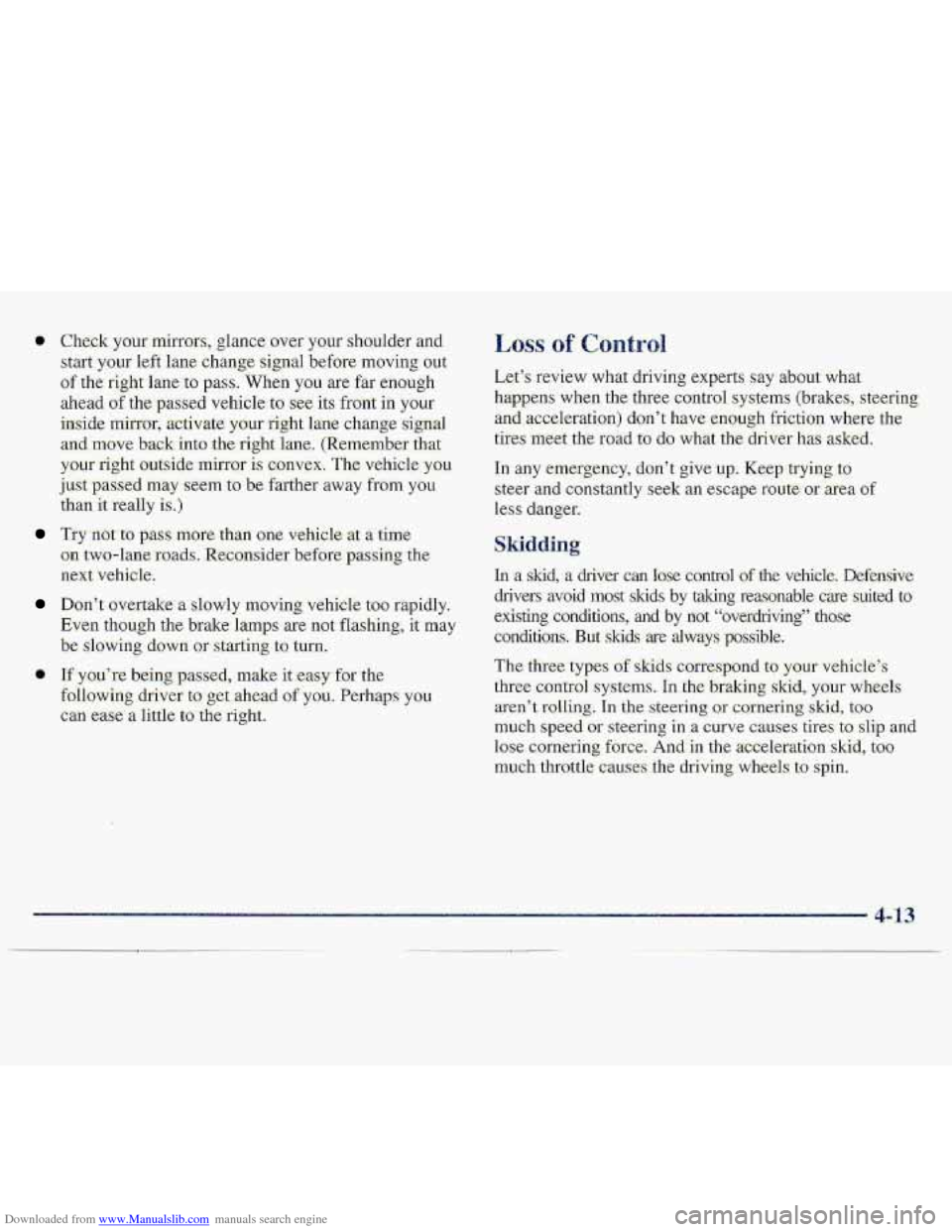
Downloaded from www.Manualslib.com manuals search engine * Check your mirrors, glance over your shoulder and.
start your left lane change
signal before-moving out
of the right.lane to pass. When you are far enough
ahead
of the passe.d vehicle to see its front in your
inside -01, activate your right lane change sigmd
and-move back into the.
ri,ght lane. (Remember that
your-right outside ,mirror is convex. The vehicle you
juslpassed may
seem to be farther away from y6u
than it really is.)
Tfy not co p.ass mufe ,than one vehicle ,at a time
on two-lane’roads. Reconsider before passing the
next vehicle.
D.on’:t overtake-.a slowly moving vehi-de too rapidly.
Even though
the brake -1amp.s are not flashing, it m.a.y
be slowing down or starting to, turn.
Qi If+ you’re being .passed, make it easy- for the
fallowing driver to
get..ahead .of you. Perh,aps you
can ease.&
little to the right.
Let’s review what driving expmts s-ay about what
happens when the thre.e
con.trol systems- (brakes., steering,
and,acceleration) don’t
have enough friction where the
tifes ”meet the road to do what the drivt?r has asked..
In any emergency, don’t give up Keep trying to
steer and constantly seek
an escape route-or aea of
less danger.
In a. skid, a driver cn lose control of .the vehicle, Defensive
drivers .avoid
most skids by taking reasonable care suited t9
existing conditiolrs, and by not “overdriving” those
conditions.. But- ,&ids
are always -pa.ssible.
The three typcis of skids correspond to your vehicle’s
three
c’0ntro1 syst,erns. In. the. brakifig skid, y0.m whe.eIs
aren’t rpl.ling. Ln the steering or- cornering skid, too
much speed or steering in a curve causes tires: to slip and
lase cornehg, foxce,. And. in the acceleration skid, too
much throttle causes the driving wheels- to spin.
4-13